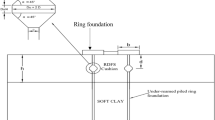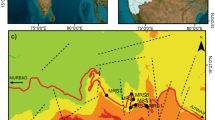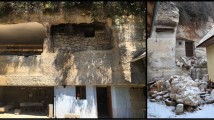Abstract
Open pit mining using drill and blast has been taking place in central Evia, Greece for many decades. This is so, due to the presence of ferronickel ores in the area. As a consequence of the mining activity, large volumes of overburden Upper Cretaceous limestone are being annually extracted and deposited at predefined sites, creating rock waste dumps or embankments. In the context of optimum land surface use and better stability conditions, a geotechnical characterization of these waste dumps has taken place and is presented in the current paper. First, image analyses are performed on fragmented limestone muckpiles and the degree and intensity of rock fragmentation due to blasting is assessed. Results compare reasonably well with computations based on the Kuz-Ram empirical model for fragmentation analysis. Overall, muckpiles on excavation faces consist of boulders and cobbles by 80–90% per weight. Following, a laboratory investigation program is executed on samples retrieved from the waste dumps. Based on the results, the dumps consist of heavily coarse grain material, mostly classified as GC. According to modified Proctor tests and in-situ density tests using the Troxler device, compaction on the crest of the dumps is characterized as very high, while permeability is empirically considered as medium to high. As far as the friction angle of the waste dump material is concerned, this is estimated based on observations (i.e. recorded inclinations of existing dumps), combined with an empirical model from the literature. Generally, it is considered that the friction angle varies considerably with the overburden pressure within the dump’s body. Nonetheless, if a single-value approach is necessary for simplicity purposes and stability considerations, then a friction angle of about 40° (characteristic value) is suggested as a reasonable assumption.

(LARCO GMMSA 2009)
















Similar content being viewed by others
References
ASTM (2007) D422-63 Standard test method for particle-size analysis of soils. ASTM International, West Conshohocken
ASTM (2010a) D2216-10 Standard test methods for laboratory determination of water (moisture) content of soil and rock by mass. ASTM International, West Conshohocken
ASTM (2010b) D4318-10 Standard test methods for liquid limit, plastic limit, and plasticity index of soils. ASTM International, West Conshohocken
ASTM (2011) D2487-11 Standard practice for classification of soils for engineering purposes (unified soil classification system). ASTM International, West Conshohocken
ASTM (2012) D1557-12 Standard test methods for laboratory compaction characteristics of soil using modified effort (56,000 ft-lbf/ft3 (2,700 kN-m/m3)). ASTM International, West Conshohocken
Barton NR (1982) Shear strength investigations for surface mining. In: Brawner (ed) Third international conference on stability in surface mining. Vancouver, Canada, Society for Mining, Metallurgy, and Exploration, Chapt 7, pp 171–196
Barton NR, Kjaernsli B (1981) Shear strength of rockfill. J Geotech Eng Div 107(7):873–891
Blight GE, Troncoso JH, Fourie AB, Wolski W (2000) Issues in the Geotechnics of Mining Wastes and Tailings. In: GeoEng 2000, Technomic Publishing, Lancaster, PA, USA, pp 1253–1285
Blight GE (2010) Geotechnical engineering for mine waste storage facilities. Taylor & Francis, Milton Park
Bornovas Ι, Rondoyanni-Tsiambaou T (1983) Geologic map of Greece, 1:500.000. IGME, Athens
Bowles JE (1996) Foundation analysis and design. McGraw-Hill, New York
Brawner CO, Broughton S (1991) Recent problems with waste rock spoil dumps. In: Proceedings of the 15th Annual British Columbia Mine Reclamation symposium, Kamloops, BC, Canada, pp 85–93
Caldwell JA, Moss ASE (1985) Simplified stability analysis. In: Mccarter MK (ed) Design of non-impounding mine waste dumps. Society for Mining, Metallurgy, and Exploration, Englewood, pp 47–61
Cunningham CVB (1983) The Kuz-Ram model for prediction of fragmentation from blasting. In: First international symposium on rock fragmentation by blasting, Luleå, Sweden, pp 439–454
Cunningham CVB (1987) Fragmentation estimations and the Kuz-Ram model—four years on. In: Second international symposium on rock fragmentation by blasting, Keystone, CO, USA, pp 475–487
Cunningham CVB (2005) The Kuz-Ram fragmentation model—20 years on. In: Brighton conference proceedings: European federation of explosives engineers, pp 201–210
Dawson RF, Morgenstern NR, Stokes AW (1998) Liquefaction flowslides in Rocky mountain coal mine waste dumps. Can Geotech J 35(2):328–343
Djordjevic N (1999) A two-component model of blast fragmentation. The AusIMM Proceedings 304(2):9–13
EN (1997) EN 932-1, Tests for general properties of aggregates. Methods for sampling
EPA (2012) Guidance on the waste management (management of waste from the extractive industries) regulations 2009. Environmental Protection Agency, USA
European Commission (2006) Directive 2006/21/EC of the European Parliament and of the Council of 15 March 2006 on the management of waste from extractive industries and amending Directive 2004/35/EC. Off J Eur Union
FHWA (1991) Rock blasting and control overbreak (FHWA-HI-92-001). US Department of Transportation—Federal Highway Administration
Holtz RD, Kovacs WD, Sheahan TC (2010) An introduction to geotechnical engineering. Prentice Hall, Upper Saddle
Hustrulid WA, Mccarter MK, van Zyl DJ (2001) Slope stability in surface mining (Sect. 3: stability of waste rock embankments). Society for Mining, Metallurgy, and Exploration, Englewood
Iabichino G, Barbero M, Cravero M, Fidelibus C, Usai G (2014) Experimental tests for the assessment of the shear strength of marble waste dumps. Environ Earth Sci 71(7):3259–3271
Kanchibotla SS, Valery W, Morrell S (1999) Modelling fines in blast fragmentation and its impact on crushing and grinding. In: Explo ‘99: a conference on rock breaking, Kalgoorlie, WA, Australia. The Australasian Institute of Mining and Metallurgy, Carlton, pp 137–144
Kemeny JM, Devgan A, Hagaman RM, Wu X (1993) Analysis of rock fragmentation using digital image processing. J Geotech Eng 119(7):1144–1160
Kuznetsov VM (1973) The mean diameter of fragments formed by blasting rock. Sov Min Sci 9:144–148 (in Russian)
LARCO GMMSA (2009) Εnvironmental impact study of West and East Kotroni, Rekavetsi, Sourzti, and Katsikiza mines (Evia), Athens
Leps TM (1970) Review of shearing strength of rockfill. J Soil Mech Found Div 96(4):1159–1170
Lilly PA (1986) An empirical method of assessing rock mass blastability. In: Davidson JR (ed) Large open pit planning conference. The Aus IMM, Parkville, pp 89–92
Lilly PA (1992) The use of the blastability index in the design of blasts for open pit mines. In: Western Australian conference on mining geomechanics. Curtin University of Technology, Perth, pp 421–426
Maerz NH, Palangio TC, Franklin JA (1996) WipFrag image based granulometry system. In: Proceedings of the FRAGBLAST 5 workshop on measurement of blast fragmentation. AA Balkema, Montreal, pp 91–99
Marachi ND, Chan CK, Seed HB (1972) Evaluation of properties of rockfill materials. J Soil Mech Found Div 98(1):95–114
Orman M, Peevers R, Sample K (2011) Waste piles and dumps. In: Darling P (ed) SME mining engineering handbook, 3rd edn. Society for Mining, Metallurgy, and Exploration, Englewood, pp 667–680
Palangio TC (1985) WipFrag—a new tool for blast evaluation. In: 11th Annual ISEE symposium on blasting research. International Society of Explosives Engineers, Nashville, pp 269–285
Pastor M, Quecedo M, Merodo JAF, Herrores MI, GonzÁlez E, Mira P (2002) Modelling tailings dams and mine waste dumps failures. Géotechnique 52(8):579–591
Piteau AE (1991) Mined rock and overburden piles: investigation and design manual—interim guidelines. In: British Columbia Mine Waste Rock Pile Research Committee (ed) British Columbia Mine Waste Rock Pile Research Committee
Poulsen B, Khanal M, Rao AM, Adhikary D, Balusu R (2014) Mine overburden dump failure: a case study. Geotech Geol Eng 32(2):297–309
Robertson AM (1986) Mine waste disposal: an update on geotechnical and geohydrological aspects. In: Eighth annual symposium on geotechnical and geohydrological aspects of waste management, Fort Collins, CO, USA. AA Balkema, Fort Collins, pp 31–50
Sharma S, Roy I (2015) Slope failure of waste rock dump at Jayant opencast mine, India: a case study. Int J Appl Eng Res 10(13):3306–33012
Smith ML, Kemeny JM (1993) Blast fragmentation model evaluation via image analysis. In: Symposium on emerging computer techniques for the minerals industry: SME, pp 229–238
Spitz K, Trudinger J (2008) Mining and the environment: from ore to metal. CRC Press, Boca Raton
Steiakakis E, Kavouridis K, Monopolis D (2009) Large scale failure of the external waste dump at the “South Field” lignite mine, Northern Greece. Eng Geol 104(3):269–279
Tougiannidis N (2009) Karbonat- und Lignitzyklen im Ptolemais-Becken: Orbitale Steuerung und suborbitale Variabilität (Spätneogen, NW-Griechenland). Sedimentologische Fallstudie unter Berücksichtigung gesteinsmagnetischer Eigenschaften. PhD Dissertation, Universität zu Köln
Valeton I, Biermann M, Reche R, Rosenberg F (1987) Genesis of nickel laterites and bauxites in Greece during the Jurassic and Cretaceous, and their relation to ultrabasic parent rocks. Ore Geol Rev 2(4):359–404
Van Zyl D (1993) Mine waste disposal. In: Daniel DE (ed) Geotechnical practice for waste disposal. Springer, Boston, pp 269–286
Wetherelt A, Wielen K (2011) Introduction to open-pit mining. In: Darling P (ed) SME mining engineering handbook, 3rd edn. Society for Mining, Metallurgy, and Exploration, Englewood, pp 857–877
Widzyk-Capehart E, Lilly P (2002) A review of general considerations for assessing rock mass blastability and fragmentation. Fragblast 6(2):151–168
Williams DJ (2001) Assessment of embankment parameters. In: Hustrulid WA, Mccarter MK, Zyl DJAV (eds) Slope stability in surface mining (Sect. 3: stability of waste rock embankments). Society for Mining, Metallurgy, and Exploration, Englewood, pp 275–284
Acknowledgements
The author would like to express his gratitude to LARCO GMMSA for permission to publish data contained in the present study. The opinions expressed in the study are the author’s own and do not necessarily reflect the view of LARCO GMMSA.
Author information
Authors and Affiliations
Corresponding author
Rights and permissions
About this article
Cite this article
Zevgolis, I.E. Geotechnical characterization of mining rock waste dumps in central Evia, Greece. Environ Earth Sci 77, 566 (2018). https://doi.org/10.1007/s12665-018-7743-5
Received:
Accepted:
Published:
DOI: https://doi.org/10.1007/s12665-018-7743-5





